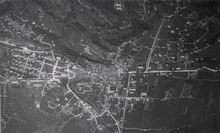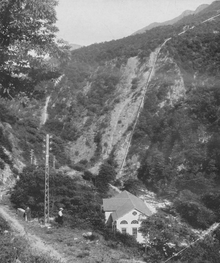Bellinzona
![]()
The title of this article is ambiguous. For other meanings, see Bellinzona (disambiguation).
![]() (Italian [belinˈtsona], in the Lombard dialect of the area simply Bórgh [bork] 'city'; German today rarely Bellenz; French Bellinzone, formerly also Bellence; Rhaeto-Romanic
(Italian [belinˈtsona], in the Lombard dialect of the area simply Bórgh [bork] 'city'; German today rarely Bellenz; French Bellinzone, formerly also Bellence; Rhaeto-Romanic![]() , Latin Bilitio) is a political municipality in the district and county of Bellinzona and the capital of the Italian-speaking canton of Ticino in Switzerland. With a population of about 43,000, Bellinzona is the second largest city in the canton after Lugano. The inhabitants are called Bellenzer, Italian Bellinzonesi.
, Latin Bilitio) is a political municipality in the district and county of Bellinzona and the capital of the Italian-speaking canton of Ticino in Switzerland. With a population of about 43,000, Bellinzona is the second largest city in the canton after Lugano. The inhabitants are called Bellenzer, Italian Bellinzonesi.
The Federal Criminal Court has its seat in Bellinzona.
Geography
Bellinzona lies in the valley plain east of the Ticino river at the foot of the Gotthard massif near the border of Sopraceneri (northern Ticino) and Sottoceneri (southern Ticino). Rocks, formed during the last ice age, protrude from the plain directly connected to the Magadino plain; they are mainly made of gneiss. The castle rock was the main reason for the construction of a fortress on this site.
The neighbouring municipalities are Arbedo-Castione, Lumino, San Vittore, Roveredo, Riviera, Sant'Antonino, Cugnasco-Gerra, Vogorno, Lavertezzo and Isone, as well as Cavargna, San Nazzaro Val Cavargna and Gravedona ed Uniti on Italian territory.
History
Bellinzona is first mentioned in 590 as ad Bilitionem, then as Bellitiona, Belizona, Berinzona, Beliciona, Birrinzona and in 1168 Birizona. The meaning is not completely clarified; most likely the place name is based on a personal name Belitius or Bellitio.
The place was of great strategic importance as the key to the St. Gotthard, Lukmanier and San Bernardino passes. Archaeologists suspect that the town has been inhabited for 4000 years. The Neolithic settlements, it is thought, were located on the slope where Castelgrande now stands. This site was easily defended and secured against floods from the Ticino. Since the 1st century B.C. the place belonged to the Roman Empire. The Roman Empire extended the fortress on the hillside. In the fifth century, the Lombards arrived in the town from the south and built a first, larger fortification on the slope of today's Castelgrande. In 590 the town was attacked by the Franks and on this occasion it was mentioned in writing for the first time. In the 11th and 12th centuries the presumed wooden palisades were replaced by stone walls.
Giovanni Visconti and Luchino Visconti besieged the town for two months in 1340 and finally conquered it; it was already an important trading centre thanks to the Gotthard Pass. In 1291 the Confederation was founded and became more and more powerful. The Dukes of Milan did not want to lose the city and therefore heavily armed it. Thus, as a line of defence against the north, the three castles were built, from west to east the Castelgrande, Castello di Montebello and Castello di Sasso Corbaro. In 1499 Louis XII of France attacked Bellinzona with his troops and took possession of it. The inhabitants secretly sold the town to the Confederates. In the Perpetual Peace of 1516, France ceded the city to the Swiss. Nevertheless, France repeatedly tried to buy it back, which the Confederates refused. In 1803, with the creation of the Canton of Ticino, when the Canton of Lugano was united with the Canton of Bellinzona, the three well-fortified castles around Bellinzona became the property of the canton.
After Bellinzona, Locarno and Lugano had alternately been the capitals of the new canton, Bellinzona became the definitive seat of the cantonal government and parliament in 1878.
In 1907, the previously independent municipalities of Carasso, Daro and Ravecchia were incorporated into Bellinzona. On 2 April 2017, the neighbouring municipalities of Camorino, Claro, Giubiasco, Gnosca, Gorduno, Gudo, Moleno, Monte Carasso, Pianezzo, Preonzo, Sant'Antonio and Sementina followed. The area of the political municipality thus increased in 2017 from 19.1 to 164.96 km², and the number of inhabitants rose from just under 19,000 to over 42,000.
Energy supply
After Faido, Lugano and Airolo, Bellinzona was the fourth town in Ticino with a power supply. The power station in the Valle di Gorduno went into operation on 1 February 1891 and supplied electricity mainly for public lighting. The idea of gas lighting was abandoned. The existing power station with a capacity of 400 hp was soon no longer sufficient to meet the additional energy requirements of private individuals and industry, including the Officina Bellinzona maintenance workshop of the Gotthard Railway, which opened in 1891. After evaluating several projects, the town decided in 1898 to build the Morobbia power station, which went into operation in 1903. The plant was extended several times and in 1947 had a capacity of 7000 hp (5.2 MW). In the early 1970s, the plant was expanded and a weekly reservoir in the shape of Lago di Carmena was added. In 2018, the power plant had a capacity of 15 MW and was able to supply one fifth of the city's electricity needs.

Historical aerial photograph by Walter Mittelholzer (1919)

Powerhouse of the Morobbia power plant in Giubiasco
Search within the encyclopedia